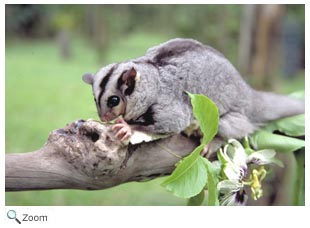Petauridae - gliders, striped possums, trioks
 There are 11 species of small marsupials in this family. They are found in
the forests of Australia and New Guinea. They have long, furry prehensile tails. Some species in this family have a thin membrane of skin that runs from their front feet to their rear feet that helps them glide from tree to tree. There are 11 species of small marsupials in this family. They are found in
the forests of Australia and New Guinea. They have long, furry prehensile tails. Some species in this family have a thin membrane of skin that runs from their front feet to their rear feet that helps them glide from tree to tree.
They eat insects and the sap and gum from
eucalypts and acacias. Species in this family include: the
striped possum, the
northern glider, the sugar glider, the
great-tailed triok, the
long-fingered triok, the
yellow-bellied glider, and the
squirrel glider.
World Status Key
 Least Concern Least Concern  Near Threatened Near Threatened  Vulnerable Vulnerable  Endangered Endangered  Critically Endangered Critically Endangered  Extinct in Wild Extinct in Wild  Extinct Extinct
Status and range is taken from ICUN Redlist. If no status is listed, there is not enough data to establish status.
US Status Key
 Threatened in US Threatened in US  Threatened in NH Threatened in NH  Endangered in US Endangered in US  Endangered in NH Endangered in NH  Breeds N.H. Breeds N.H.  Introduced Introduced
Status taken from US Fish and Wildlife and NH Fish and Game
New Hampshire Species |
|
North/Central American Species |
None
|
|
None |
Additional Information
Key:  Profile Profile  Photos Photos  Video Video  Audio Audio
Leadbeater's Possum - Gymnobelideus leadbeateri     
Leadbeater's possum is found in Victoria, Australia.
Source: Arkive Intended Audience: General Reading Level: Middle School Teacher Section: Yes
Leadbeater's Possum - Gymnobelideus leadbeateri    
Leadbeater's possum is gray-brown with a dark stripe running down its back. Unlike some of the other species in this family, it does not have a gliding membrane.
Source: Animal Diversity Web Intended Audience: General Reading Level: Middle School Teacher Section: Yes
Leadbeater's Possum - Gymnobelideus leadbeateri    
Leadbeater's possum was thought to be extinct until it was rediscovered in 1961.
Source: EDGE Intended Audience: General Reading Level: Middle School Teacher Section: No
Mahogany Glider - Petaurus gracilis     
The mahogany glider is found in Queensland, Australia.
Source: Arkive Intended Audience: General Reading Level: Middle School Teacher Section: Yes
Mahogany Glider - Petaurus gracilis   
The mahogany glider is a solitary species.
Source: Animal Diversity Web Intended Audience: General Reading Level: Middle School Teacher Section: Yes
Mahogany Glider - Petaurus gracilis    
The mahogany glider is reddish-brown and has a dark brown stripe on its head.
Source: Queensland Government Intended Audience: General Reading Level: Middle School Teacher Section: No
Mahogany Glider - Petaurus gracilis     
The mahogany glider has a deep 'Nwarr' call.
Source: Wildlife Queensland Intended Audience: General Reading Level: Middle School Teacher Section: No
Squirrel Glider - Petaurus norfolcensis   
The squirrel glider is found in eastern Australia.
Source: Arkive Intended Audience: General Reading Level: Middle School Teacher Section: Yes
Squirrel Glider - Petaurus norfolcensis   
Squirrel gliders live in family groups made up of one adult male and one or more adult females as well as the young squirrel gliders from the breeding season.
Source: Animal Diversity Web Intended Audience: General Reading Level: Middle School Teacher Section: Yes
Squirrel Glider - Petaurus norfolcensis     
Squirrel gliders have long, thick, bushy tails.
Source: Wildlife Queensland Intended Audience: General Reading Level: Middle School Teacher Section: No
Striped Possum - Dactylopsila trivirgata     
The striped possum is found in Australia, Indonesia, and Papua New Guinea.
Source: Animal Diversity Web Intended Audience: General Reading Level: Middle School Teacher Section: Yes
Sugar Glider - Petaurus breviceps      
The sugar glider is found in Australia, Indonesia; and Papua New Guinea.
Source: Arkive Intended Audience: General Reading Level: Middle School Teacher Section: Yes
Sugar Glider - Petaurus breviceps     
Sugar gliders
can hibernate if it gets too cold or if food supplies are low.
Source: Animal Diversity Web Intended Audience: General Reading Level: Middle School Teacher Section: Yes
Sugar Glider - Petaurus breviceps      
Sugar gliders have a sharp "yip-yip" call.
Source: Wildlife Queensland Intended Audience: General Reading Level: Middle School Teacher Section: No
Tate's Triok - Dactylopsila tatei   
Tate's triok is found in Papua New Guinea.
Source: Arkive Intended Audience: General Reading Level: Middle School Teacher Section: Yes
Yellow-bellied Glider - Petaurus australis    
The yellow-bellied glider is found in eastern Australia.
Source: Arkive Intended Audience: General Reading Level: Middle School Teacher Section: Yes
Yellow-bellied Glider - Petaurus australis    
The yellow-bellied glider can glide distances of as much as 370 feet.
Source: Animal Diversity Web Intended Audience: General Reading Level: Middle School Teacher Section: Yes
Yellow-bellied Glider - Petaurus australis     
The yellow-bellied glider is also known as the fluffy glider.
Source: Wildlife Queensland Intended Audience: General Reading Level: Middle School Teacher Section: No |

